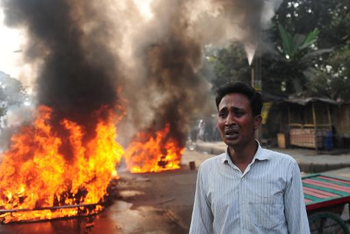 Dhaka, Dec 15: The death toll in violence across Bangladesh triggered by the execution of a top Jamaat-e-Islami leader on Saturday rose to 21, prompting Prime Minister Sheikh Hasina to issue a stern warning saying, “We know how to control you.”
Dhaka, Dec 15: The death toll in violence across Bangladesh triggered by the execution of a top Jamaat-e-Islami leader on Saturday rose to 21, prompting Prime Minister Sheikh Hasina to issue a stern warning saying, “We know how to control you.”
Abdul Quader Mollah, known as the “Butcher of Mirpur” for atrocities committed during Bangladesh’s 1971 Liberation War, was hanged on Thursday night after the Supreme Court rejected his review petition. He was the first politician to be put to death for war crimes.
Speaking at a rally on Saturday commemorating the martyrs of 1971 war, Ms. Hasina accused her arch-rival main opposition Bangladesh Nationalist Party (BNP) chief Khaleda Zia of backing Jamaat to protect the perpetrators of crimes against humanity.
“We have shown enough patience. We will not tolerate anymore. People of the country know how to reply these atrocities, we (government) also know how to respond to, control you,” she said.
Her comments came as Jamaat called a nationwide strike today to protest the hanging of Mollah.
Violence erupted at several places soon after his execution, which the Jamaat described as a “political murder” even as it vowed to take revenge.
Jamaat activists set ablaze the house of State Home Minister Shamsul Haque Tuku in Pabna, which was rented out to the local passport office. One room of the two-storey building was damaged when the activists hurled a petrol bomb, police said.
Three deaths were reported on Saturday from southeastern Laxmipur, where clashes between Jamaat workers and police broke out after a local leader of the party was allegedly found dead hours after he was picked up by security personnel.
Seven persons died when Jamaat cadres clashed with police at several places, including Noakhali, Satkhira, Khulna and Jessore on Friday.
The dead included six leaders and activists of the Jamaat, two Awami League workers, a BNP activist and a street vendor.
Two Awami League activists were killed in clashes with Jamaat activists in northwestern Nilphamari where they tried to attack the motorcade of Awami League lawmaker and leading actor Asaduzzaman Noor.
Noor escaped unhurt as paramilitary Border Guard Bangladesh (BGB) and police intervened as escorted him to safety.
The Jamaat activists tried to torch a police camp at Narayanganj, a suburb of Dhaka.
Unidentified persons damaged two Hindu idols at a temple in northwestern Sirajganj.





Comments
Add new comment